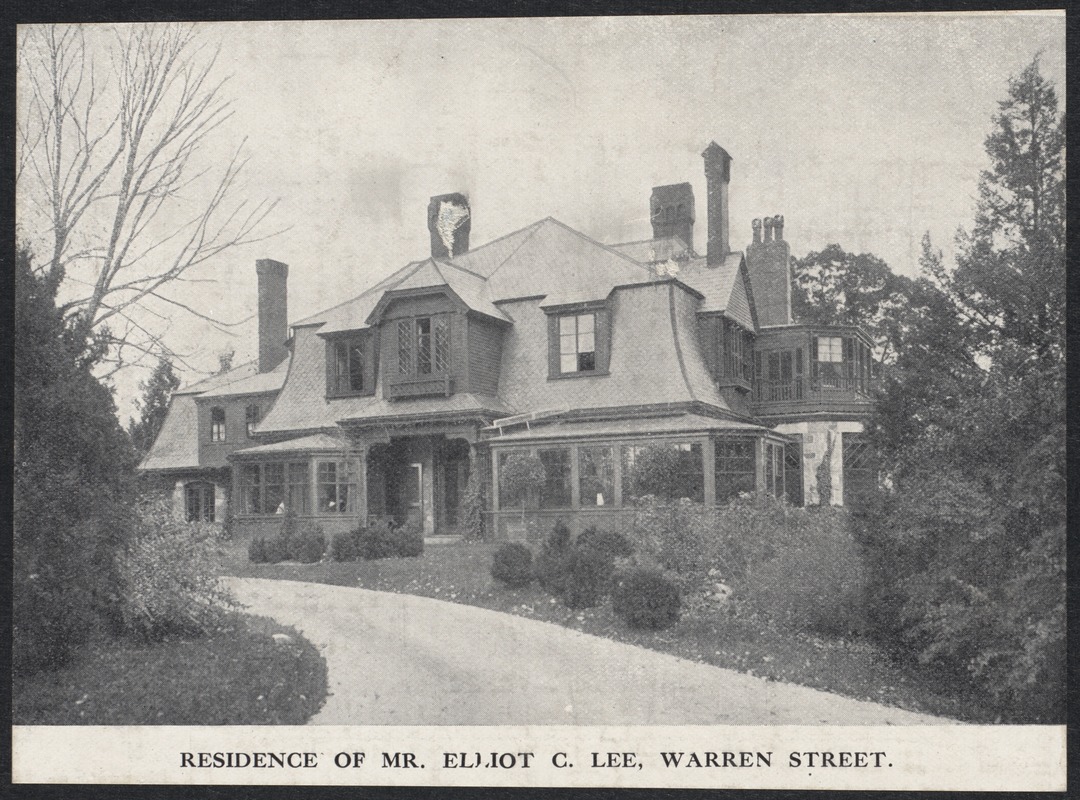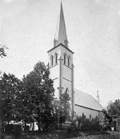 |
450 Warren St.
Still standing.
[Source: Digital Commonwealth]
|
 |
Fourth of July Parade, 1899
One of a series of photos taken for The Suburban newspaper.
[Source: Digital Commonwealth]
|
 |
Fourth of July Parade, 1899
One of a series of photos taken for the The Suburban newspaper. A cropped version entitled “Review of the Troops by the Selectmen in Front of Town Hall” appeared on page 2 of the July 8, 1899 issue.
[Source: Digital Commonwealth]
|
 |
Fourth of July Parade, 1899
One of a series of photos taken for the The Suburban newspaper.
[Source: Digital Commonwealth]
|
 |
30 Warren St., 1902
The Hunts and their daughter lived here with five-six servants. The house was built in 1885 for Moses Williams and it still stands.
The photograph was taken by Thomas E. Marr, then well-known as a photographer of wealthy area residents.
[Source: Digital Commonwealth]
|
 |
Collision of Fire Trucks, October 18, 1919
This accident occurred during a response to a small fire on Crowninshield Rd. Ladder Truck B was leading Combination AA on Pleasant St. preparing to turn on to Crowninshield Rd. A misunderstanding of the intended movement of Ladder Truck B caused Combination AA to collide with it and spin 180 degrees. Several firefighters were thrown from the truck and hoseman Michael J. Mahon was killed. An émigré from Galway, Ireland, he lived in Brookline Village with his wife and five children with a sixth child on the way. After working as a gardener he began work for the fire department in 1916 and was working at Station A in the Village Square at the time of the accident.
Photo by Leslie Jones who worked for the Boston Herald-Traveler newspaper between the years 1917 and 1956.
[Source: Leslie Jones Collection]
|
 |
619 Boylston St.
Overlooking the reservoir from the corner of Fisher Ave. Replaced circa 1950 by the house currently at 25 Fisher Ave.
[Source: Digital Commonwealth]
|
 |
Shurtleff House, Boylston St.
Roughly located at 269 Boylston St. near the NE corner with Cypress St. It was originally built as a school in 1820 and modeled from a Greek temple, with Doric pillars. A Boston physician, Dr. Samuel Atwood Shurtleff purchased it circa 1844 and converted it for use as his home.
[Source: Brookline Preservation Department]
|
 |
Taylor House, Dudley St., circa 1876
The reservoir is in the distance. Located roughly at today's 54 Dudley St. No longer standing.
From Photographs of Brookline: taken about 1876 / Richard Hills. Call No.: BROOKLINE/Special (CAGE B.R. 974 H6), Brookline Public Library.
[Source: Brookline Preservation Department]
|
 |
First Parish Church, Third Building, circa 1876
This is the third iteration of the First Parish Unitarian Church. It replaced the second building, on the same site, in 1848 and, in turn, was torn down in 1891 and replaced by the current First Parish Unitarian Church. Photo by Richard Hills.
[Source: Brookline Preservation Department]
|
 |
Beacon St. East of Cleveland Circle, circa 1900
Looking at the north side of outer Beacon St., Clinton Rd. is in the foreground. On the far left is the house at 1842 Beacon St., no longer standing.
[Source: Brookline Preservation Department]
|
 |
Beacon St. East of Cleveland Circle, circa 1900
Looking at the north side of outer Beacon St., Clinton Rd. is in the foreground. Center left is the building at 1874-1880 Beacon St. that still stands. The south side of Beacon is completely undeveloped.
[Source: Brookline Preservation Department]
|
 |
150 Fisher Ave.
No longer standing. Looking west.
[Source: Brookline Preservation Department]
|
 |
Bird's Stationery Shop
Mellen True Bird (1860 – 1945) opened a Brookline branch of his Boston stationery store in 1932 at 1286 Beacon St. at the corner of Pleasant St. The business was later taken over by his children and remained at that location for over twenty years.
[Source: Brookline Preservation Department]
|
 |
219 Fisher Ave.
[Source: Brookline Preservation Department]
|
 |
150 Fisher Ave.
[Source: Brookline Preservation Department]
|
 |
Boylston St., circa 1900
Looking east, Reservoir Lane. is unseen around the corner. This photo is likely made of the just-completed widening of Boylston St. and the laying of trolley tracks in late 1900. Note that the supporting poles of the electric feed stop abruptly on the north side where the trolley tracks cease sharing the general roadway. The poles resume on the specially laid-out segregated section of track that goes up the hill.
[Source: Digital Commonwealth]
|
 |
Family Members of John Lowell Gardner at 135 Warren St., 1864
The house is still standing today. The initial version of the house was built in 1806 by Nathaniel Ingersoll, one of several wealthy international-trade merchants who had houses in the immediate area. John Lowell Gardner purchased the house in 1842 and a number of additions were made over the years. This photo appears to be one of several taken circa 1864, each showing a slightly different configuration of family members.
[Source: Historic New England]
|
 |
John D. Runkle School
Looking east at 50 Druce St. The first building, on the right, was opened in 1897. The other two, forming three quarters of a quadrangle, were added in 1902. They were all replaced by the current school in 1962.
[Source: Digital Commonwealth]
|
 |
John D. Runkle School, circa 1900
Looking east at 50 Druce St. This is an early photo of the first building that was opened in 1897. Two more were added in 1902 to form three quarters of a quadrangle. They were all replaced by the current school in 1962.
[Source: Digital Commonwealth]
|